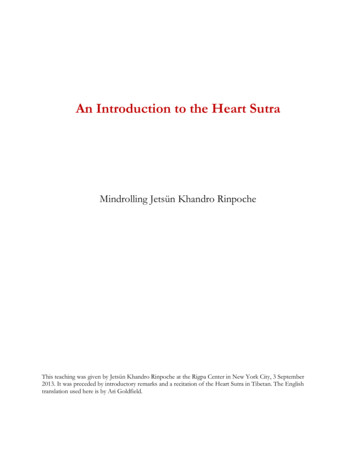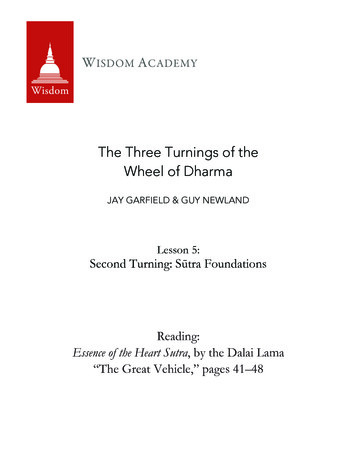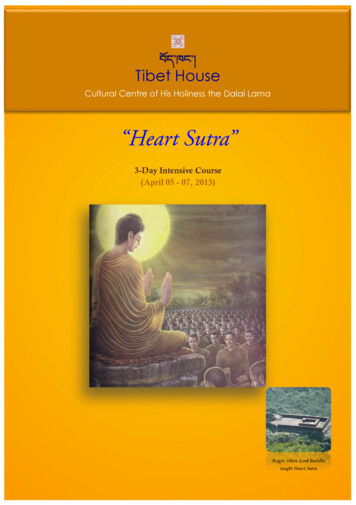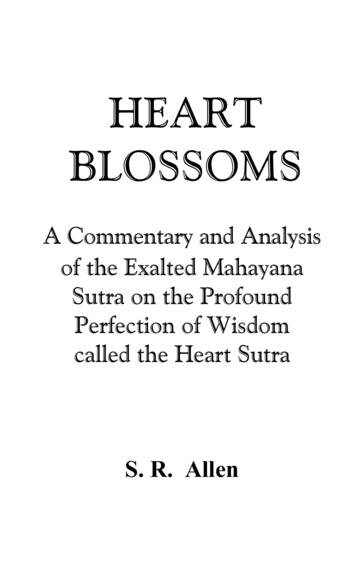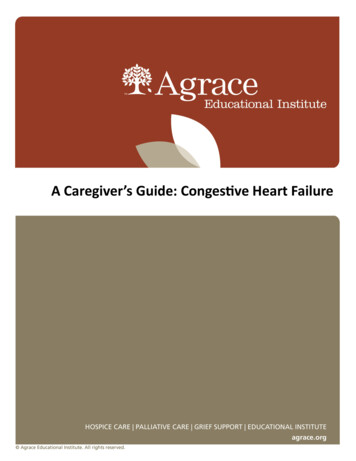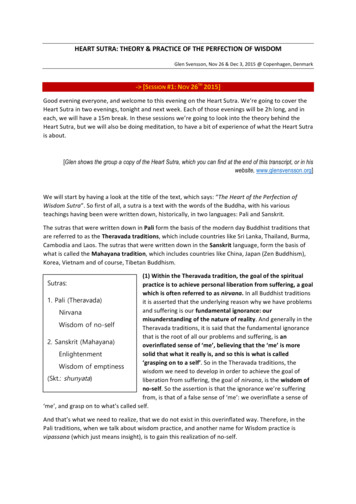
Transcription
HEART SUTRA: THEORY & PRACTICE OF THE PERFECTION OF WISDOMGlen Svensson, Nov 26 & Dec 3, 2015 @ Copenhagen, Denmark- [SESSION #1: NOV 26TH 2015]Good evening everyone, and welcome to this evening on the Heart Sutra. We’re going to cover theHeart Sutra in two evenings, tonight and next week. Each of those evenings will be 2h long, and ineach, we will have a 15m break. In these sessions we’re going to look into the theory behind theHeart Sutra, but we will also be doing meditation, to have a bit of experience of what the Heart Sutrais about.[Glen shows the group a copy of the Heart Sutra, which you can find at the end of this transcript, or in hiswebsite, www.glensvensson.org]We will start by having a look at the title of the text, which says: “The Heart of the Perfection ofWisdom Sutra”. So first of all, a sutra is a text with the words of the Buddha, with his variousteachings having been were written down, historically, in two languages: Pali and Sanskrit.The sutras that were written down in Pali form the basis of the modern day Buddhist traditions thatare referred to as the Theravada traditions, which include countries like Sri Lanka, Thailand, Burma,Cambodia and Laos. The sutras that were written down in the Sanskrit language, form the basis ofwhat is called the Mahayana tradition, which includes countries like China, Japan (Zen Buddhism),Korea, Vietnam and of course, Tibetan Buddhism.(1) Within the Theravada tradition, the goal of the spiritualpractice is to achieve personal liberation from suffering, a goalwhich is often referred to as nirvana. In all Buddhist traditions1. Pali (Theravada)it is asserted that the underlying reason why we have problemsand suffering is our fundamental ignorance: ourNirvanamisunderstanding of the nature of reality. And generally in theWisdom of no-selfTheravada traditions, it is said that the fundamental ignorancethat is the root of all our problems and suffering, is an2. Sanskrit (Mahayana)overinflated sense of ‘me’, believing that the ‘me’ is moresolid that what it really is, and so this is what is calledEnlightenment‘grasping on to a self’. So in the Theravada traditions, theWisdom of emptinesswisdom we need to develop in order to achieve the goal of(Skt.: shunyata)liberation from suffering, the goal of nirvana, is the wisdom ofno-self. So the assertion is that the ignorance we’re sufferingfrom, is that of a false sense of ‘me’: we overinflate a sense of‘me’, and grasp on to what’s called self.Sutras:And that’s what we need to realize, that we do not exist in this overinflated way. Therefore, in thePali traditions, when we talk about wisdom practice, and another name for Wisdom practice isvipassana (which just means insight), is to gain this realization of no-self.
(2) On the Sanskrit traditions, which are the basis for the Mahayana tradition, the goal of thespiritual path is enlightenment. And enlightenment is not simply to liberate ourselves fromsuffering, but to achieve this state of full awakening so that we can help liberate everyone fromsuffering as well. And in the Mahayana traditions, what is stopping us from achievingenlightenment, our fundamental ignorance, is that we believe that there is an independent ‘me’here and an independent, objective, world out there. Within the Sanskrit tradition, it is said to bethis ignorance that is the root of all of our suffering. So the wisdom we need to develop to achieveenlightenment is what’s called the wisdom of emptiness (emptiness in Sanskrit: shunyata). So herewe are to realize that there is no independent ‘me’ and no independent, objective, world outthere: this is what emptiness means.As we will see, the Heart Sutra is part of the Sanskrit tradition, the Mahayana tradition, and talksabout how to cultivate this wisdom of emptiness. So that’s what we will be looking at, in the HeartSutra.So just to have a look at the rest of the title, we see in the title that it says: “The Heart of thePerfection of Wisdom” and then in brackets, underneath, we have the original Sanskrit title, whichreads So in the middle, we see the word ‘prajnaparamita’, and ‘prajna’ is a Sanskrit word that meanswisdom, and ‘paramita’ means perfection, so ‘prajnaparamita’ is the Perfection of Wisdom. So thisperfection of wisdom is to realize this emptiness, that there is no independent ‘me’, no independentand objective world out there.After the word ‘prajnaparamita’ we also see the word ’hridaya’, which means heart or essence. Buthere the word heart doesn’t mean some sort of emotion, it means essence, like in the expression‘the heart of the matter’. So this Heart Sutra contains the essence of all the perfection of wisdomteachings in the Sanskrit tradition. There are many sutras, in Sanskrit, teaching emptiness, but theHeart Sutra is the essence of all of those, is a condensed version of all the perfection of wisdomteachings, and so in very few words we have the essence of the perfection of wisdom teachings onemptiness.And then we also see the word ‘Arya-bhagavati’. ‘Bhagavati’ is the feminine of ‘Bhagavan’, and‘Bhagavan’ is just another name for Buddha, someone who is fully enlightened. And ‘Arya’ isreferring to someone who has had a direct realization of emptiness, which has directly realized thenature of reality.But here what we see in the title is the feminine version: ‘Bhagavan’ is male and ‘Bhagavati’ is thefemale. In Buddhism, wisdom is considered to be feminine, because in the Buddhist spiritual path,we talk about the two aspects of wisdom and compassion, and intuitively we may think: compassionis more feminine and wisdom more masculine, but in Buddhism it’s the opposite: wisdom isconsidered to be feminine and compassion masculine. The reason wisdom is considered to befeminine is that it’s wisdom that gives birth to nirvana and enlightenment, so wisdom gives birth tothese arya beings. So that’s why wisdom is considered to be feminine.HEART SUTRA: THE THEORY & PRACTICE OF THE PERFECTION OF WISDOM Glen Svensson, Nov 26 & Dec 3, 2015 @ Copenhagen, Denmark1
So this is what we see in the title ‘Arya-bhagavati-prajnaparamita-hridaya-sutra’. So this sutra orteaching of the Buddha, is teaching the perfection of wisdom of emptiness, that says that nothingexists independently: there’s no independent ‘me’, no independent objective world. And this sutracontains these teachings in very few words. So that’s basically the title.What we will do now, which is very traditional, is that in many of the Mahayana traditions the HeartSutra plays a very important role, so much so that quite often people recite the Heart Sutra in a dailybasis. Also often, when there’s a teaching being given, especially if the teaching is about wisdom, asan auspicious sign, at the beginning of teaching the Heart Sutra is also recited. So before we look atthe actual Heart Sutra, I thought it might be nice if we read the Heart Sutra together.[Glen then read the Heart Sutra with the group.]Ok, let’s see if we can make some sense of all of that.So what we see in this translation of the Heart Sutra is a lot of outlines embedded in the text. Ofcourse these outlines were not in the original sutra, but they were added later in time, so that wecan more easily see the structure of the Heart Sutra, and how all of its elements fit together.And what we see in the first two outlines is that the first two paragraphs are the prologue, which isbasically the setting of the sutra. So commonly at the beginning of any sutra we will find the setting,with elements like where it took place, who was there and so far. So here the prologue is dividedinto two parts, the common and uncommon prologue. The (i) common prologue is something incommon with all the other sutras, basically describing a couple of basic elements of the sutra, likewhere it took place, who the teacher was, and who was present. So this is found in the firstparagraph.Glen reads:1A. Common prologueThus did I hear at one time. The Bhagavan was dwelling on Mass of Vultures Mountain inRajagriha together with a great community of monks and a great community ofbodhisattvas.Comments:- so it begins by saying that the teaching only occurred in one occasion.- then it says the ‘Bhagavan’, which is just another word for Buddha (which was BuddhaShakyamuni), was present.- Rajagriha is a city in modern day Bihar, India, and Rajagriha literally means ‘The Palace of the King’,so this city, at the time of the Buddha, was actually the place where the King of this whole regionHEART SUTRA: THE THEORY & PRACTICE OF THE PERFECTION OF WISDOM Glen Svensson, Nov 26 & Dec 3, 2015 @ Copenhagen, Denmark2
lived. And just outside Rajagriha there’s a smallhill, here called ‘Mass of Vultures Mountain’,sometimes called ‘Vulture’s Peak’, which is afamous Buddhist pilgrimage site in India.So you can go there now and visit ‘Vulture’sPeak’, seeing the place where the Buddhaactually gave this teaching. So that’s where theteaching took place, on this little hill outsideRajagriha, which these days is about a 2h drivefrom Bodhgaya, the place where the Buddhaachieved enlightenment.Vulture’s Peak, Rajgir, India- as for the reference of monks and bodhisattvas,here the word monks is referring to those who are following the path to nirvana, where abodhisattva is someone who is following the path to enlightenment. Of course we’re not saying thatall monks only follow the path to nirvana, but here in this section, that’s what it means. So that’swho’s present: the Buddha was present, in this little hill called ‘Vulture’s Peak’ outside Rajagriha,and a lot of monks and bodhisattvas were also present.In the next paragraph, the (ii) uncommon prologue, is describing what is unique to this sutra, what isthe unique setting of this sutra.Glen reads:1B. Uncommon prologueAt that time, the Bhagavan was absorbed in the concentration on the categories ofphenomena called “Profound Perception.” Also, at that time, the bodhisattva mahasattvaarya Avalokiteshvara looked upon the very practice of the profound perfection of wisdomand beheld those five aggregates also as empty of inherent nature.Comments:- so we often find, in these sorts of sutras, the word profound, which is another word for emptiness,because emptiness is something very profound, very difficult to realize. So when it says profoundperception, we’re talking about perceiving the profound, and the profound is emptiness. So we’retalking about the fact that the Buddha was seating there, absorbed in realizing emptiness, inrealizing the nature of reality.HEART SUTRA: THE THEORY & PRACTICE OF THE PERFECTION OF WISDOM Glen Svensson, Nov 26 & Dec 3, 2015 @ Copenhagen, Denmark3
- also Avalokiteshvara is a Sanksrit word (in Tibetan:Chenrezig) considered to be the Buddha of Compassion.But here its calling Avalokiteshvara a bodhisattva, which issomeone who is aspiring to enlightenment, aspiring tobecome a Buddha. So here Avalokiteshvara is appearing asa bodhisattva, for the benefit of the audience.He’s also being called a ‘mahasattva’, and ‘maha’ meansgreat, and ‘sattva’ means courage or strength, so a‘mahasattva’ is someone who has great courage orstrength. And here it means someone who is working withgreat courage or strength to help liberate everyone fromsuffering. So Avalokiteshvara is also present, and the textsays he looked at the practice of the profound perfection ofwisdom, the practice of realizing that nothing existsindependently, so Avalokiteshvara was also realizingemptiness.- then it says ‘he beheld those five aggregates also asempty of inherent nature’. The five aggregates are something that comes up a lot in these teachings,and here the five aggregates are a way of presenting the basis of a person. If we want to keep itsimple, a person has two parts: the body and the mind and in this five aggregates presentation, thefirst of the five aggregates is called the form aggregate, which in respect to a person, refers to thebody. The other four aggregates, collectively, are the mind.So when we see in the text the five aggregates, we’re talking about the body and the mind of aperson. So the text then says he hold these five aggregates, ie, the body and the mind, also asempty of independent nature. The expression independent nature is another way of saying thatthings are empty of independent existence, that they have no inherent nature. So the text says thebody and the mind are also independent of inherent nature. So what that is implying is that it’s notjust the person that is empty of inherent nature, but also the basis of the person, the body and themind are empty of inherent nature. So Avalokiteshvara was also realizing that the person doesn’tindependently exist, the body doesn’t independently exist and that the mind doesn’t existindependently.So this is the setting: we have the Buddha seating there realizing emptiness, we haveAvalokiteshvara also realizing emptiness, and then if we go the next part, the actual subject matterof the sutra, we have in the next paragraph, another person being introduced, which is Shariputra.Glen reads:2. Subject matter of the actual sutra2A. Shariputra’s question on the mode of practicing the perfection of wisdomThen, through the power of Buddha, the venerable Shariputra said this to the bodhisattvamahasattva arya Avalokiteshvara: “How should any son of the lineage train who wishes topractice the activity of the profound perfection of wisdom?”HEART SUTRA: THE THEORY & PRACTICE OF THE PERFECTION OF WISDOM Glen Svensson, Nov 26 & Dec 3, 2015 @ Copenhagen, Denmark4
Comments:- so who is Shariputra? Often when we see a picture of the Buddha, we see in the sides, standing up,two of his disciplines, this is a very common way of depicting the Buddha. One of these disciples isShariputra. And then the text reads Then, through the power of Buddha, the venerable Shariputrasaid this to the bodhisattva mahasattva arya Avalokiteshvara. So what we’re going to see actually inthis sutra – and a sutra represents the words of the Buddha –, is mostly a discussion betweenAvalokiteshvara and Shariputra, with Shariputra asking a question and then Avalokiteshvara’s reply.But this is a sutra, the words of the Buddha.What’s key in this statement, is the expression ‘through the power of Buddha’. So what does thismean? It means that the Buddha, through the power of his concentration, is actually orchestratingthis discussion, so he’s inspiring Avalokiteshvara and Shariputra to have this discussion.- So then Shariputra asks a question to Avalokiteshvara: “How should any son of the lineage trainwho wishes to practice the activity of the profound perfection of wisdom?” So what does the wordlineage mean here? Generally, in practice, we can follow different lineages, and in the Mahayanatradition, we’re following the Mahayana lineage to enlightenment, so a son or daughter of thelineage is someone who is aspiring to follow the Mahayana path. And we become a son ordaughter of the lineage when we develop Great Compassion . So when we develop GreatCompassion , wishing to liberate everyone else from suffering as well, we are a son or daughter ofthe Mahayana lineage.So this is what Shariputra is asking, how should anyone interested in following the Mahayana path toenlightenment, should practice this wisdom of emptiness? How are they to go about that? This iswhat Shariputra’s question.- Then we see that Avalokiteshvara’s reply, which is most of the sutra, it’s divided into sections, andAvalokiteshvara’s response, on how to practice this wisdom of emptiness, can be related to thedifferent stages of the Mahayana path to enlightenment.And we can see that in your other handout, to which we will look in detail later.[Glen showed the group a handout with the title Mahayana path, which you can find in his website- www.glensvensson.org]So we can see the Mahayana path to enlightenment is divided into 5 stages:(1) Path of Accumulation(2) Path of Preparation(3) Path of Seeing(4) Path of Meditation(5) Path of No More Learning.So these are five stages we go through, on our striving for enlightenment. And Avalokiteshvara’sreply is telling how us to practice these wisdom of emptiness, at each one of those 5 stages.HEART SUTRA: THE THEORY & PRACTICE OF THE PERFECTION OF WISDOM Glen Svensson, Nov 26 & Dec 3, 2015 @ Copenhagen, Denmark5
The first part of his answer is telling how should we practice this wisdom of emptiness, in the firsttwo stages of the path: the Path of Accumulation and Path of Preparation - that’s the section we’regoing to look at this evening.Anyone has any questions?Q.: Is this text the full length of the Heart Sutra?A.: Yes, it is. What you actually find is that the Heart Sutra plays a very important role in all of theMahayana traditions, and often you’ll find, I think that on Chinese and Zen traditions, when theyread the Heart Sutra, the prologue and the rejoicing that’s at the end of the text, they don’t recitethose sections, only the core Heart Sutra, while on the Tibetan tradition you’ll also have thatprologue and the conclusion. But yes, this is the full length of the Heart Sutra. It’s 25 stanzas, it’sactually very short, very brief. That’s why it’s called the Heart Sutra, the essence.Q.: Calling the Buddha the ’Bhagavan’; why are there several names for the same person?A.: In fact that are many more names for the Buddha, also ‘Tathagata’, ‘Sugatata’, ‘Jina’, you couldfind a list with several more, and each one of those has a particular meaning. What we’re going tosee at the end of the sutra next week, is the use of ‘Tathagata’, and ‘ta’ means to go and ‘Tathaga’is another word for emptiness, so ‘Tathagata’ is someone who has gone to emptiness, meaningsomeone who has completely realized emptiness, so a Buddha is someone who has done that. Sothe use of that name is emphasizing that fact.As for ‘Bhagavan’, ‘van’ means to possess, and ‘Bhaga’ can be understood as what’s called fortuneor qualities, so ‘Bhagavan’ is someone who possesses particular qualities (and there’s a list of 6qualities, but that’s out of our scope for now), but often the word ‘Bhagavan’ can mean someonewho is possessing these qualities of the Buddha, and it can also mean someone who has eliminatedall the faults as well, so there is a specific etymology with all of these.So now let’s have a look at Avalokiteshvara’s reply.This evening we will be covering the first part of his reply, which refers to how we are to practicethis wisdom of emptiness on the first two stages of the path. Actually, implicitly, he’s also talkingabout how are we, as beginners, to practice (even if we’re not even technically ‘on the path’). So ifwe think: “Oh, we’re not at the end of the path, so this doesn’t apply to us”, actually the first part ofthe answer applies to us as well, because to actually enter the Path of Accumulation, we have todevelop this aspiration called bodhicitta, this aspiration for enlightenment, to a level where it turnsinto something spontaneous within us. So maybe we don’t have this spontaneous wish to achieveenlightenment to help others, maybe we don’t have that right now, and that’s something on whichwe have to work a little bit. So maybe we’re really a little before the beginning of the path.But actually the instructions we see now in the Heart Sutra, also relate to us, as beginners, they’rethe same instructions, so they definitely apply to us.HEART SUTRA: THE THEORY & PRACTICE OF THE PERFECTION OF WISDOM Glen Svensson, Nov 26 & Dec 3, 2015 @ Copenhagen, Denmark6
Q.: So emptiness has nothing to do with enlightenment, it’s just a method?A.: As we’re going to see, emptiness is saying that everything is empty of inherent existence, and inthe Mahayana tradition, if we want to achieve enlightenment, we have to come to directly realizethat. If we realize emptiness directly, again and again and again and again and again, eventually wewill wipe out all the ignorance in our mind and we will achieve enlightenment. So someone who is inan enlightened state, is realizing emptiness all the time. So that’s the relationship betweenenlightenment and emptiness.Q.: Is the mind that realizes emptiness, the same or different from the emptiness that it realizes?A.: Same or different? Neither! We will touch on that later.So now let’s have a look at the first part of the answer.Glen reads:2B. Avalokiteshvara’s responses2B1. Individual presentation of the mode of training in the path of those of inferior faculties2B1A. Presentation of the mode of training in the perfection of wisdom on the path ofaccumulation and the path of preparation2B1A-1. TransitionHe said that and the bodhisattva mahasattva arya Avalokiteshvara said this to thevenerable Shariputra. “Shariputra, any son of the lineage or daughter of the lineage whowishes to practice the activity of the profound perfection of wisdom should look upon itlike this,Comments:- so remember that a ‘son or daughter of the lineage’ is someone that has developed GreatCompassion and is aspiring to follow the Mahayana path to enlightenment, someone who has thataspiration, how should they practice this wisdom of emptiness?- so the first part of the answer is the brief answer, and that very brief answer is:HEART SUTRA: THE THEORY & PRACTICE OF THE PERFECTION OF WISDOM Glen Svensson, Nov 26 & Dec 3, 2015 @ Copenhagen, Denmark7
Glen reads:[2B1A-2. Mode of training in brief]correctly and repeatedly beholding those five aggregates also as empty of inherent nature.Comments:- here the ‘correctly and repeatedly’, could also be translated as ‘to subsequently see in a correctway’, which probably makes more sense. So what does that mean? It means to subsequentlyinvestigate, so that we come to see that things are empty of inherent nature. What that implies isthat to come to initially realize emptiness we have to use reasoning and logic. We have to infer thatactually things are empty of independent existence, because emptiness is not something we cansee directly now. So we have to use reasoning and logic to come to correctly infer that indeedthings don’t exist independently. So that’s what we’re going to be doing here, in trying to establishthis view of emptiness, through reason and logic.- and remember that the five aggregates are simply a way to say the body and the mind, and so‘also’ means that not only the person is empty of inherent existence, but the basis of the person arealso empty of inherent nature, they do not independently exist.- so in its brief answer he’s also indicating the sequence in which we should investigate the nature ofreality. When we come to investigate it, we can investigate anything: a cup, a laptop, the body, themind, but here what’s implied is that we should start by investigating ourselves as a person, how dowe exist?So this is what this brief answer is telling us, on what to do.And to go into that, which we will do after the break, in the most classic statements of the HeartSutra, where it says: “Form is empty. Emptiness is form. Emptiness is not other than form; form isalso not other than emptiness.” So that’s probably the best well known part of the Heart Sutra, andin there, there’s a lot of meaning, namely what emptiness really means, what it means that thingsare empty of independent existence.So now, before the tea break, as suggested in the Heart Sutra, we will begin our investigation ofreality by focusing on ourselves as a person. So what we’re going to do now is use reasoning andlogic, in meditation, to come to see subsequently in a correct way, that there’s no independent ‘me’here.That’s what we’re going to do now, so please find a comfortable posture please.HEART SUTRA: THE THEORY & PRACTICE OF THE PERFECTION OF WISDOM Glen Svensson, Nov 26 & Dec 3, 2015 @ Copenhagen, Denmark8
MEDITATION INSTRUCTIONS:[40:00] Beginning.[40:22] So begin by allowing your awareness to descend into the body, and simply become aware ofsensations throughout the body.[40:57] If you notice any areas of tension in the body, then use the outbreath to relax and releasethat tightness or tension.[41:40] Now bring your awareness to the area of your face, softening and relaxing all the muscles inthe face, allowing the jaws to be soft and relaxed. Then all the muscles around the eyes soft andrelaxed.[42:35] In this way, allow your entire body to become completely relaxed, completely at ease.[43:20] Then relaxing more deeply, with each outbreath.[44:00] Allowing the breathing to settle into its natural rhythm, not trying to control it or regulate itin anyway. Simply allowing it to flow naturally and without effort.[45:00] Then with each outbreath, letting go of any thoughts that may have arisen. Happily releasingthem.[45:35] And simply allowing the mind to come to rest in the present moment.Simply becoming aware of sensations of the breath throughout the body, where you most easilynotice any sensations associated with the breath.[46:40] Maintaining an ongoing flow of mindfulness of the sensations of the breath, throughout thebody.[47:20] Now, do you have a sense that there’s a ‘me’ here, a ‘me’ who is meditating? A ‘me’ thatdoes not seem to depend upon anything else to exist? Do you have this experience? This experienceof ‘me’, the meditator.[48:20] The ‘me’ that seems to be here meditating Can this ‘me’ be found anywhere?Can ‘me’, the meditator, be found anywhere in the body? Search thoroughly in any part of the bodyand look for the ‘me’ that is meditating.[49:40] Is the ‘me’ who is meditating to be found somewhere inside the head? Is the brain the ‘me’who is meditating?[50:20] Or is the brain simply something which I possess? Something which ‘me’, the meditator, isusing?[50:50] Is the whole body itself, is that the ‘me’ who is meditating?[51:20] Or is the whole body itself simply something that I possess? Something which ‘me’, themeditator, is trying to relax?[52:20] Is me the meditator, to be found somewhere in the mind?Again, search thoroughly any part of the mind, and look for the ‘me’ which is meditating.HEART SUTRA: THE THEORY & PRACTICE OF THE PERFECTION OF WISDOM Glen Svensson, Nov 26 & Dec 3, 2015 @ Copenhagen, Denmark9
[53:00] Are any of the thoughts, emotions or memories in the mind, are any of these the ‘me’ who ismeditating?[53:30] Or are thoughts, emotions and memories simply things that I possess? Things which ‘me’, themeditator, has?[54:05] Is the mind itself, the ‘me’ who is meditating? Or is the mind itself simply something which I,the meditator, possess? Something which ‘me’, the meditator, is trying to train?[54:50] Is the combination of the body and the mind, is that the ‘me’ who is meditating here? Or isthe combination the body and the mind, simply two things that I possess? Two things that I, themeditator, is trying to train?[55:50] Apart from the body and the mind, what else is there here? If there’s nothing more than thebody and the mind here, where is the ‘me’ who possesses this body and mind? Which is trying totrain the body and the mind? Where is the ‘me’ who is meditating?[57:10] Even if you didn’t find the ‘me’ who is meditating, isn’t someone experiencing all of this?So there is a ‘me’ here meditating. And just because we don’t seem to be able to find it, it doesn’tmean that it doesn’t exist.It simply means that it is empty of findable independent existence.[58:00] The ‘me’ which is here meditating is the dependent ‘me’. A ‘me’ that exists depending on thebody and the mind. A ‘me’ that is merely labeled, on the basis of the body and the mind.[58:30] End of meditation.So let’s take a 15m break and have a cup of tea.SESSION BREAKSo we’re looking at the Heart Sutra, and again the word heart means essence, the essence of theperfection of wisdom sutra. Perfection of wisdom is then this wisdom of emptiness, so this sutracontains the essence of the teachings on emptiness.And we’re now starting to have a look at Avalokiteshvara’s response to Shariputra, in terms of howto practice this wisdom of emptiness in the various stages along the Mahayana path toenlightenment. And what we already saw was that in the initial stages of the path, emptiness issomething we have to realize first through reasoning and logic, through inference, to thensubsequently see in a correct way, that everything is empty of an independent existence. And sowe’re now going to have a look at this famous statement on form and emptiness,HEART SUTRA: THE THEORY & PRACTICE OF THE PERFECTION OF WISDOM Glen Svensson, Nov 26 & Dec 3, 2015 @ Copenhagen, Denmark10
Glen reads:2B1A-3A. Mode of training in the ultimate nature of the aggregate of formForm is empty. Emptiness is form. Emptiness is not other than form; form is also not otherthan emptiness.Comments:- 1) First statement: ‘Form is empty’. So remember that formhere is one of the five aggregates, with the five aggregatesbeing the presentation of the basis of the person, so theform aggregate is really talking about the body. Soeffectively, what this statement is saying is ‘The body isempty’.1. ‘Form is empty’(independent existence)Reasoning: same or different2. ‘Emptiness is form’But when we see statements like this, we have to ask: emptyof what? And here emptiness doesn’t mean that nothingreally exists. This is not saying that the body is empty, andtherefore is doesn’t really exist. What it is saying is that theThings are empty of beingbody is empty of inherent nature, or in other words, empty of independent existence. So thisstatement, that things are empty of independent existence or inherent nature, this is emptiness.So emptiness is not saying that nothing really exists, but it is saying that things are notindependently existing. So this is the ultimate nature of form, or the body. In fact, as we see in theHeart Sutra, emptiness is the ultimate nature of everything, nothing exists independently. And aswe saw initially, to realize this, we come at it by using reason and logic. And that’s a little bit theapproach we used in the me
Heart Sutra in two evenings, tonight and next week. Each of those evenings will be 2h long, and in each, we will have a 15m break. In these sessions we’re going to look into the theory behind the Heart Sutra, but we will also be doing meditation, to have a bit of experience of what the Heart Sutra
